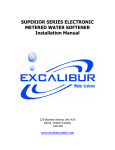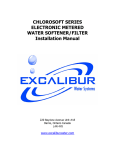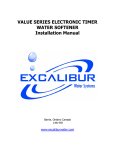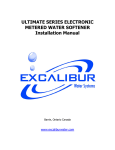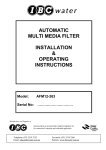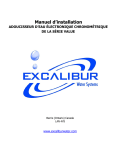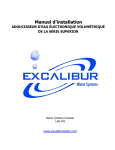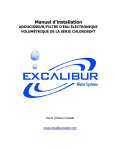Download Excalibur Water Systems 2.0" High Capacity Premium Flow Series Installation manual
Transcript
PREMIUM SERIES ELECTRONIC METERED WATER SOFTENER Installation Manual 220 Bayview Avenue Unit #18 Barrie, Ontario Canada L4N 4Y8 www.excaliburwater.com EXCALIBUR PREMIUM WATER SOFTENER INSTALLATION MANUAL GENERAL WATER SOFTENER INSTALLATION PROCEDURES The Water Softener control valve, fittings and/or bypass Water Softener valve are designed to accommodate minor plumbing misalignments that may occur during the Water Softener installation. Do Not use Vaseline, oils or other hydrocarbon lubricants when installing your Premium Water Softener or spray silicone anywhere. A silicone lubricant may be used when installing your Premium Water Softener on black o-rings but is not necessary. Avoid any type of lubricants including silicone when installing your Premium Water Softener on red or clear lip seals. Do not use pipe dope or other sealants on the Water Softener threads. Teflon tape must be used on the Water Softener threads such as the 1 inch NPT elbow, the ¼ inch NPT connection, and the Water Softener drain line connection. The nuts and caps of the Premium Water Softener are designed to be unscrewed or tightened by hand or with the special plastic Water Softener service wrench part number V3193. If necessary, pliers can be used to unscrew the Premium Water Softener nut or cap. No not use a pipe wrench to tighten or loosen the Premium Water Softener nuts or caps. Do not place screwdriver in slots on caps and/or tap with a hammer as this could damage the Premium Water Softener WATER SOFTENER INSTALLATION SITE REQUIRMENTS • Water pressure 20 – 125 psi • Water temperature 5 to 30°C or 40 to 100°F • The Water Softener tank should be on a firm level surface • Electrical use of 115/120 volt 60 Hz uninterrupted outlet • Current draw is 0.25 amps • A 15 foot power cord is furnished • The plug-in transformer is for dry location only • Batteries are not used 1. The distance between the Premium Water Softener and the water drain should be as short as possible. When installing your Premium Water Softener all plumbing must be done in accordance with local plumbing codes. The Water Softener must not have a piping header that exceeds 3 meters (10 feet). 2. Since water softener salt must be used periodically and be added to the Water Softener, the brine tank should be located where it is easily accessible. 3. Do not install your Premium Water Softener with less than 10 feet of piping between your Water Softener and it’s electrical outlet and the inlet of the water heater. 4. Do not locate the Premium Water Softener where it’s connections including the Water Softener drain and overflow plumbing will be in a room with a room temperature under 2°C or 34°F. 5. The use of resin cleaner in your Premium Water Softener in an unvented enclosure is not recommended. 6. The Water Softener inlet/outlet plumbing will be installed downstream of outdoor spigots. Install an inlet shutoff valve and plumbing to the Water Softener bypass valve located at the right rear as you face the Water Softener. There are a variety of Water Softener installation fittings available. They are listed under Water Softener installation fitting assemblies. When assembling the Water Softener installation fitting package (inlet and outlet) connect the fitting to the plumbing system first and attach the Water Softener nut, split ring and o-ring. Heat from soldering or solvent cements may damage the Water Softener nut, split ring or o-ring. Solder joints should be cool and solvent cements should be set before installing the Water Softener nut, split ring and o-ring. Avoid getting solder flux, primer and solvent cement on any part of the Water Softener o rings, split rings, bypass valve or control valve. If the building electrical system is grounded to the plumbing system, install a copper grounding strap from the inlet to the outlet plumbing. 7. WATER SOFTENER DRAIN LINE First, be sure that the Water Softener drain line can handle the flow rate of the Water Softener. Solder joints near the drain line must be done prior to connecting the Water Softener drain line flow control fitting. Leave at least 6 inched between the Water Softener drain line flow control fittings and solder joints. Failure to do this could cause interior damage to the Water Softener flow control. Install a ½ inch inside diameter flexible plastic tube to the Water Softener drain line assembly or discard the tubing nut and the 3/4 inch NPT fitting for rigid pipe. If the Water Softener backwash flowrate is greater than 7 gallons per minute, use a ¾ inch Water Softener drain line. Where the Water Softener drain line is elevated but empties into a water drain below the level of the Water Softener control valve, form a 7 inch loop at the discharge end of pipe so that the bottom of the loop is level with the drain connection of the Water Softener control valve. This will provide an adequate anti-siphon trap. Where the drain empties into an overhead sewer pipe, a sink-type trap must be used. Run a drain tube to its discharge point in accordance with local plumbing codes. Pay special attention to plumbing codes for air gaps and anti-siphon devices. 8. WATER SOFTENER BRINE TANK CONNECTION Install a 3/8 inch outside diameter polyethylene tubing from the Water Softener refill elbow to the brine valve in the Water Softener brine tank. 9. WATER SOFTENER OVERLOW DRAIN TUBING CONNECTION A Water Softener overflow drain tubing is recommended where a Water Softener brine tank overflow could damage furnishings or the building structure. Your Premium Water Softener will be equipped with a brine tank safety float which greatly reduces the chance of an accidental brine overflow. In the event of a Water Softener malfunction, an overflow tubing connection will direct the overflow to the drain instead of spilling on the floor where it could cause considerable damage. This fitting should be on the side of the Water Softener cabinet of brine tank. To connect the Water Softener overflow fitting, locate a hole inside of the brine tank. Insert the Water Softener overflow fitting into the brine tank and tighten with plastic nut and gasket from the inside. Attach a length of ½ inch inside diameter tubing (not supplied) to fitting and run tubing to drain. Do not elevate the Water Softener overflow tube higher than 3 inches below bottom of overflow fitting. Do not “tie” this overflow tube into the drain tube of the Water Softener control valve. Overflow tube must be a direct, separate line from fitting to drain. IMPORTANT: Never insert a drain line directly into a drain, sewer line or ptrap. Always allow an air gap between the drain line of the waste water to prevent the possibility of sewage being backsiphoned in the Water Softener. 10. WATER SOFTENER SERIAL NUMBER Record the Water Softener serial number on the installer’s records and consumer’s sales invoice. 11. WATER SOFTENER BYPASS VALVE The Water Softener bypass valve is typically used to isolate the Water Softener control valve from the plumbing system, water pressure in order to perform Water Softener control valve repairs or maintenance. The bypass valve is particularly unique due to its versatility and design features. The 1 inch Water Softener full flow bypass valve incorporates four positions including a diagnostic position that allows to work on a pressure system while still providing untreated bypass valve water to the residence. The bypass valve is completely non-metallic, all composite design. The Water Softener bypass valve consists of two interchangeable plug valves that are operated independently by red arrow shaped handles. The handles identify the water flow direction of the water. The plug valves enable the bypass valve to operate in four positions. A) NORMAL OPERATION POSITION The inlet and outlet handles point in the direction of water flow of the Water Softener indicated by the engraved arrows on the bypass valve. Water flows through the bypass valve during normal operation and this position also allows the bypass valve to isolate the Water Softener resin bed during the regeneration cycle. B) BYPASS POSITION The inlet and outlet handles point to the centre of the bypass valve. The bypass valve is isolated from the water pressure contained in the plumbing system. Untreated water is supplied to the plumbing system C) DIAGNOSTIC POSITION The inlet handle points in the direction of water flow and outlet handle points to the centre of the bypass valve. System water pressure is allowed to flow to the Water Softener control valve and the plumbing system while not allowing water to exit from the control valve to the plumbing system. D) SHUTOFF POSITION The inlet handles points to the centre of the bypass valve and the outlet points to the direction of flow. The water is shut off to the plumbing system. If water is available on the outlet side of the Water Softener, it is an indication of water bypass around the system. WATER SOFTENER STARTUP INSTRUCTIONS • After Water Softener installation is completed and checked for leaks, rotate the bypass valve handles to the bypass position. • Fully open a cold water tap to release air pressure from plumbing system. Allow water to run until the plumbing system is rid of debris, which may have occurred during installation. THE WATER SOFTNER IS NOW READY FOR TESTING 1. With the bypass valve in the bypass position, manually pour 5 gallons of water into the Water Softener brine tank. 2. Press and hold the Water Softener regeneration button for three seconds until the motor drive starts. Wait until the motor stops and the display reads “Backwash”. The backwash time will begin to count down. 3. Open the inlet handle of the bypass valve very slowly allowing water to fill the Water Softener slowly to expel air. If water flows too rapidly, there will be a loss of media out of the drain. 4. When the Water Softener is flowing steadily to drain without the presence of air, press the Water Softener regeneration button to advance the Water Softener control valve to the brine position. The brine time will begin to countdown. 5. Fully open the inlet of the Water Softener bypass valve (bypass is no in the diagnostic position). Check to verify that water is being drawn from the brine tank. There should be a slow flow to the drain. Allow three minutes for the media bed to settle. 6. Press the Water Softener regeneration button to advance the Water Softener control valve to where the display reads fill. This will allow water to run into the brine tank and prepare it for the next regeneration. Allow the brine to fill automatically. 7. While the Water Softener brine tank is filling, load two 20kg bags of water softener salt. WATER SOFTENER PROGRAMMING SETTINGS Step I: Press next and up simultaneously for 3 seconds. Step II: Set hardness in grains per gallon using the up and down buttons. The default is 15 with a valve range of 1 to 150 in 1 grain increments. The display will show NA if filter is selected. Add 5 gains of hardness for every one part of iron, then press next to go to Step III. Step III: Day override when gallon is set to off sets the number of days between regenerations when gallon capacity is set to auto or to a number sets the maximum number of days between regenerations. If valve set to off regeneration initiation is based solely on gallons used. If valve is set as a number allowable range 1 to 28 days. A regeneration initiation will be called for on that day even if sufficient number of gallons were not used to call for regeneration. Set day override using down or up buttons. Step IV: Press next regeneration time (hour). Set the hour of the day for regeneration using down or up buttons. AM/PM toggles after 12. The default time is 2:00AM. To initiate a manual regeneration immediately, press and hold the regen button for three seconds. The system will begin to regenerate immediately. The Water Softener control valve may be stepped through the various regeneration cycles pressing the regen button. Table 15 Troubleshooting Procedures Problem 1. Timer does not display time of day 2. Timer does not display correct time of day 3. No softening/filtering display when water is flowing Possible Cause a. Transformer unplugged b. No electric power at outlet a. Connect power b. Repair outlet or use working outlet c. Defective transformer d. Defective PC board a. Switched outlet b. Power outage c. Replace transformer d. Replace PC board a. Use uninterrupted outlet b. Reset time of day c. Defective PC board a. Bypass valve in bypass position b. Meter connection disconnected c. Restricted/stalled meter turbine c. Replace PC board a. Put bypass valve in service position b. Connect meter to PC board c. Remove meter and check for rotation or foreign material d. Replace meter e. Replace PC board a. Reset control valve to correct time of day b. Reset to correct time of day c. Reset regeneration time d. Check control valve set-up procedure regeneration time option e. Check control valve set-up procedure regeneration time option a. Press NEXT and REGEN for 3 seconds or unplugged power source jack (black wire) and plug back in to reset control valve b. Check piston and spacer stack assembly for foreign matter c. Replace piston(s) and spacer stack assembly d. Press NEXT and REGEN for 3 seconds or unplug power source jack (black wire) and plug back in to reset control valve d. Defective meter e. Defective PC board a. Power outages 4. Control valve regenerates at wrong time of day 5. ERROR followed by code number Error Code 1001 – Unable to Recognize start of regeneration Error Code 1002 – Unexpected stall Error 1003 – Motor ran to long, timed out trying to reach next cycle position Error Code 1004 – Motor ran to long, timed out trying to reach home position If other Error Codes display contact the factory Solution b. Time of day not set correctly c. Time of regeneration incorrect d. Control valve set at "on 0" (immediate regeneration) e. Control valve set at NORMAL + on 0 a. Control valve has just been serviced b. Foreign matter lodged in control valve c. High drive forces on piston d. Control valve piston not in home position e. Motor not inserted fully to engage pinion, motor wires broken or disconnected, motor failure f. Drive gear label dirty or damaged, missing or broken gear g. Drive bracket incorrectly aligned to back plate h. PC board is damaged or defective i. PC board incorrectly aligned to drive bracket e. Check motor and wiring. Replace motor if necessary f. Replace or clean drive gear g. Reset drive bracket properly h. Replace PC board i. Ensure PC board is correctly snapped on to drive bracket Problem 6. Control valve stalled in regeneration 7. Control valve does not regenerate automatically when REGEN button is depressed and held 8. Control valve does not regenerate automatically But does when REGEN Button is depressed Possible Cause a. Motor not operating b. No electric power at outlet c. Defective transformer d. Defective PC board e. Broken drive gear or drive cap assembly f. Broken piston retainer g. Broken main regenerant piston a. Transformer unplugged b. No electric power at outlet c. Broken drive gear or drive cap assembly Solution a. Replace motor b. Repair outlet or use working outlet c. Replace transformer d. Replace PC board e. Replace drive gear or drive cap assembly f. Replace drove cap assembly g. Replace main regenerant piston a. Connect transformer b. Repair outlet or use working outlet c. Replace drive gear or drive cap assembly d. Defective PC board a. By-pass valve in bypass position b. Meter connection disconnected c. Restricted/stalled meter turbine d. Replace PC board a. Put bypass valve in normal operation position b. Connect meter to PC board c. Remove meter and check for rotation or foreign matter d. Replace meter e. Replace PC board f. Check control valve set-up procedure a. Reset the time of day d. Defective meter e. Defective PC board f. Set-up error 9. Time of day flashes on and off a. Power has been out more than two hours, the transformer was unplugged and then plugged back into the wall outlet, the transformer plug was unplugged and then plugged back into the board or the NEXT and REGEN buttons Were pressed to reset the valve.












